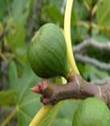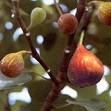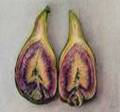| Kingdom | Plantae |
| Division | Gnetophyta |
| Class | Gnetopsida |
| Order | Urticales |
| Family | Moraceae |
| Genus | Ficus L |
| Species | F. carica |
| Binomial name | Ficus carica |
Other Common Names:
The other common names for the shrub fig are Bornholm's Diamond, Fig tree, Common fig and Garden fig.
History
Figs are originally from small Asia and are one of the first fruits cultivated ever. The Greek mention them and around 60 A.C. and Plato promoted the fig as being the nutrition for athletes. A story is known of the Greek government that had forbidden all export of figs once to assure themselves a good outcome at The Olympic Games.


Description
Figs are broadly spreading shrub or small tree with a height of 25 feet and a width greater than or equal to the height. The bark is smooth and silvery Gray, somewhat warty. The leaves are alternate, simple, deciduous; 5 inches in diameter, but sometimes larger; palmately lobed with (usually) 5 finger-like lobes, dark green above and lighter green below, petiole exudes a milky sap, somewhat scabrous, margins entire and wavy. Flowers are either male and female or all female and are not showy, green, and fleshy and rounded, the actual flowers minute, located on the inner surface of a hollow receptacle.


Range
Originally from the eastern Mediterranean region, figs have been cultivated by humans for over 5000 years. It is indigenous to Persia, Asia Minor and Syria, but now is wild in most of the Mediterranean countries. The so-called Common Fig (F. carica) is a temperate species from the Middle East and southern Europe, which has been widely cultivated from ancient times for its fruit, also referred to as figs.
Habitat
It thrives best in average, well-drained moisture. Drought tolerant, once established. Typically found at an altitude of 0 to 4,653 meters. The fig grows best and produces the best quality fruit in Mediterranean and dryer warm-temperate climates. With extra care figs will also grow in wetter, cooler areas.
Cultivation
Fig trees are propagated by cuttings, which should be put into pots and placed in a gentle hot-bed. They may be obtained more speedily from layers, and these when rooted will form plants ready to bear fruit the first or second year after planting. Fig plants are usual propagated by cuttings. Select foot-long pieces of dormant wood, less than 1 inch diameter, with two-year-old wood at base. One-year twigs with a heel of two-year branch at the base may also be used. Dip the cuttings in a rooting hormone and allow them to callus one week in a moist place at 50-60° F. Summer cuttings may also be made, but they do best if defoliated and winterized in a refrigeration for 2-3 weeks before potting. Leafy shoots require a mist bed. Particularly rare cultivars may be propagated on rootstocks, or older trees, top worked by whip, cleft or crown grafting, or chip or patch budding. Rooted cuttings should be planted in 22 to 30 feet squares, depending upon the capacity of the soil and the ultimate size of the tree. Keep roots moist until planted. Never transplant or disturb a young tree while it is starting new growth in spring, as this is likely to kill it. Cut the tree back to 2 ft high upon planting and whitewash the trunk.
When the fruits are ripe, they are collected and dried in the sun. 'Natural' Figs are those which are packed loose and retain to some extent their original shape. 'Pulled' Figs have been kneaded and pulled to make them supple; they are usually packed for exportation in small square or circular boxes the latter being termed 'drums' - and are considered to be the best variety. A few bay leaves are put upon the top of each box, to keep the fruit from being injured by a gnat which feeds on it and is very destructive.
Flowering Season
The flowers of the fig are generally in bloom from February through July.
Pests and Diseases
Figs are more susceptible to nematode damage. Recently planted trees are particularly susceptible to water deficits, often runt out, and die. It is susceptible to thrips, spider mites, mealybugs, leaf spots, scale insects and diseases like southern blight. Leaf spots are caused by fungi or bacteria. Brown or black spots and patches may be either ragged or circular, with a water soaked or yellow-edged appearance. Insects, rain, dirty garden tools, or even people can help its spread. Plants with Southern blight have lesions on the stem at, or near, the soil line.
Parts Used

The most commonly used parts of the plant are its fruit which are used for its commercial and medicinal applications.
Medicinal Commercial Applications


• Enjoy it as a house plant for the winter and then add some international flair to your deck or patio in the summer.
• Figs have long been employed for their nutritive value and in both their fresh and dried state form a large part of the food of the natives of both Western Asia and Southern Europe.
• A sort of cake made by mashing up inferior Figs serves in parts of the Greek Archipelago as a substitute for bread.
• Alcohol is obtained from fermented Figs in some southern countries, and a kind of wine, still made from the ripe fruit.
• Figs are used for their mild, laxative action, and are employed in the preparation of laxative confections and syrups.
• Figs are demulcent as well as nutritive.
• Demulcent decoctions are prepared from them and employed in the treatment of catarrhal affections of the nose and throat.
• Roasted and split into two portions, the soft pulpy interior of Figs may be applied as emolient poultices to gumboils, dental abscesses and other circumscribed maturating tumours.
• The milky juice of the freshly-broken stalk of a Fig has been found to remove warts on the body.
• The milky juice of the stems and leaves is very acrid and has been used in some countries for raising blisters.
• The porous wood is fit for fuel.
• Dried figs contain a lot of sugar and that was the reason Greek athletes ate many figs.
• It was supposed to represent the universal energy and was used as a remedy against infertility and to incite the breast feeding process.

The Common Fig tree (Ficus carica) is the first plant cited in the Bible. In Genesis 3:7 is described how Adam and Eva cover themselves with fig leaves when they discover that they are naked. The fig fruit is also included in the list of food found in the Promised Land, according to the Thorah.
It is also used in the sacred dramas of the Middle Ages to represent the Fig tree into which Zaccheus climbed and that in which the Virgin Mary on her journey into Egypt had hidden herself and the infant Jesus to avoid the fury of Herod; a legend quoted by Stapel on Theophrastus and by Thevenot in his Voyage de Levant: "At Mathave is a large sycamore or Pharaoh's Fig, very old, but which bears fruit every year. They say that upon the Virgin passing that way with her son Jesus and being pursued by the people, this Fig tree opened to receive her and closed her in again, until the people had passed by and then opened again. The tree is still shown to travellers.
It was one of the principal articles of sustenance among the Greeks, being largely used by the Spartans at their public table; and athletes fed almost entirely on figs, considering that they increased their strength and swiftness. To such an extent, indeed, were figs a part of the staple food of the people in ancient Greece that there was a law forbidding the exportation of the best fruit from their trees. Additionally, the fig tree has profoundly influenced culture through several religious traditions. It is one of the two sacred trees of Islam.
The Fig plays an important part in Latin mythology. It was dedicated to Bacchus and employed in religious ceremonies. The wolf that suckled Romulus and Remus rested under a Fig tree, which was therefore held sacred by the Romans, and Ovid states that among the celebrations of the first day of the year by Romans, Figs were offered as presents. The inhabitants of Cyrene crowned themselves with wreaths of Figs when sacrificing to Saturn, holding him to be the discoverer of the fruit. Pliny speaks also of the Wild Fig, which is mentioned also in Homer, and further classical references to the Fig are to be found in Theophrastus, Dioscorides, Faro and Columella.